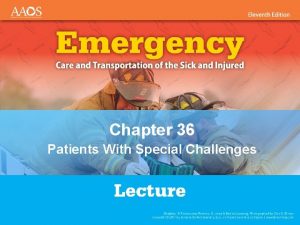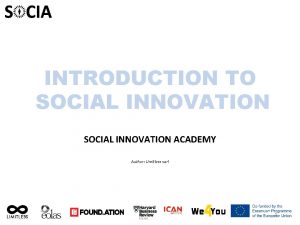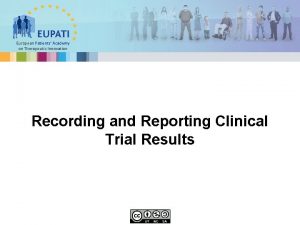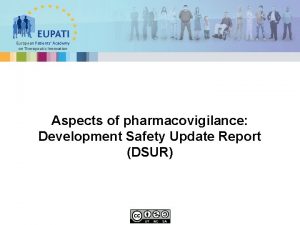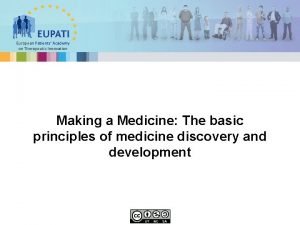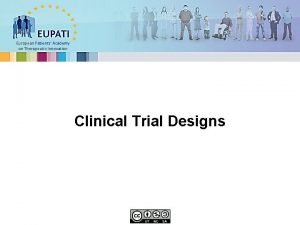European Patients Academy on Therapeutic Innovation Special Populations











- Slides: 11

European Patients’ Academy on Therapeutic Innovation Special Populations

What groups are defined as special populations? European Patients’ Academy on Therapeutic Innovation § Some groups in the general population may require special study within the clinical development process: Ø elderly Ø patients with impaired excretion Ø pregnant women Ø breast feeding women Ø children Ø ethnic sub-groups § These groups may have unique benefit-risk considerations or they may need to use a different dose or treatment schedule. 2

Elderly people European Patients’ Academy on Therapeutic Innovation § The use of medicines in this population requires special consideration due to: Ø the frequent occurrence of underlying diseases Ø use of other medicines at the same time and the consequent risk of medicines interaction 3

Elderly people European Patients’ Academy on Therapeutic Innovation § Not all potential differences that can occur in the elderly population can be predicted from non-elderly populations. This might include differences in: Ø pharmacokinetics - what the body does to the medicine Ø pharmacodynamics - what the medicine does to the body Ø interactions between the medicine and existing diseases Ø interactions between the tested medicine and other medicines the patient might be taking Ø clinical response - the effect of the medicine on the disease 4

Patients with impaired excretion European Patients’ Academy on Therapeutic Innovation § People who may have difficulty removing the medicine from their body due to kidney or liver problems. § Specific pharmacokinetic studies are needed to observe the effects of the medicine in these patients. § These studies should include elderly patients, or younger patients with impaired excretion. 5

Pregnant women European Patients’ Academy on Therapeutic Innovation § In general, pregnant women should be excluded from clinical trials where the medicine is not intended for use in pregnancy. § If a woman becomes pregnant whilst receiving a medicine, treatment should be stopped (if can be done safely). 6

Pregnant women European Patients’ Academy on Therapeutic Innovation § Special attention must be paid to reproductive toxicity studies before pregnant women are included in clinical trials. § For clinical trials that include pregnant women because the medicine is intended for use during pregnancy, it is very important to follow up the: Ø pregnancy, Ø foetus, and Ø child 7

Breastfeeding women European Patients’ Academy on Therapeutic Innovation § In some cases the medicine (or its metabolites) will be excreted into human milk and this should be examined. § When breastfeeding women are taking part in clinical trials, their children should be monitored for the effects of the medicine. 8

Children (paediatrics) European Patients’ Academy on Therapeutic Innovation § Children represent an especially vulnerable population, thus, clinical trials involving children should be carried out under conditions that give the best possible protection for each age category. § Age categories are defined as: Ø preterm new born infants (born before 37 weeks gestation) Ø term new born infants (0 to 27 days) Ø infants and toddlers (28 days to 23 months) Ø children (2 to 11 years) Ø adolescents (12 to 16/18 years, depending on region) 9

Children (paediatrics) European Patients’ Academy on Therapeutic Innovation § Safety data from adults should be available and assessed before children are included in clinical trials. § It is usually appropriate to begin with older children before extending the trial to younger children, and then to infants. § The organisation developing a medicine should submit the mandatory paediatric investigation plan (PIP) early enough to ensure that the medicine can be appropriately developed for children. 10

Ethnic groups/regions European Patients’ Academy on Therapeutic Innovation § Differences in ethnic factors could alter the efficacy or safety of the medicine in the population. § A limited amount of clinical data may need to be generated in ‘bridging studies’. Understanding a medicine’s characteristics will determine what sort of bridging studies are needed in ethnic sub-groups or different regions. § Pharmacokinetics, pharmacodynamics and therapeutic effects could be impacted by ethnic factors. § The type of medicine concerned, its indication, as well as the age and/or sex of a patient can influence how ethnic factors change a medicine’s effect. 11
 Kar 5
Kar 5 Tracheostomy stoma
Tracheostomy stoma Innovation for the sake of innovation
Innovation for the sake of innovation Radical vs disruptive innovation
Radical vs disruptive innovation European institute for innovation and sustainability
European institute for innovation and sustainability Innovation procurement european commission
Innovation procurement european commission Social innovation academy
Social innovation academy Business innovation
Business innovation European patent academy
European patent academy Reflect thinking
Reflect thinking European agency for development in special needs education
European agency for development in special needs education Special education academy
Special education academy

